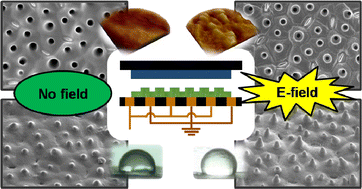Hydrophobic polymer surfaces by lotus leaf replication using an alternating current electric field with an interdigitated electrode
Abstract
We fabricated a hydrophobic surface of polycaprolactone (PCL) and dynamic hydrophobic surface of poly(ethylene oxide) (PEO), which is an inherently hydrophilic material, by varying the surface pattern that is replicated with the lotus leaf. To improve the replication efficiency, we applied an electric field-aided technique, supplemented with an interdigitated electrode. Electrostriction occurred due to the electric field applied to the liquid


 Please wait while we load your content...
Please wait while we load your content...